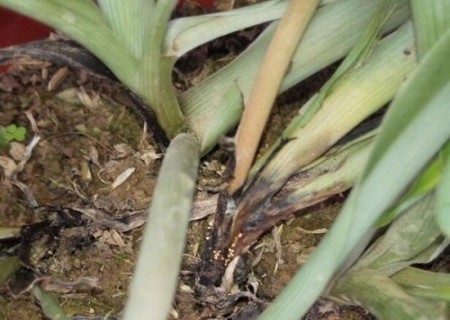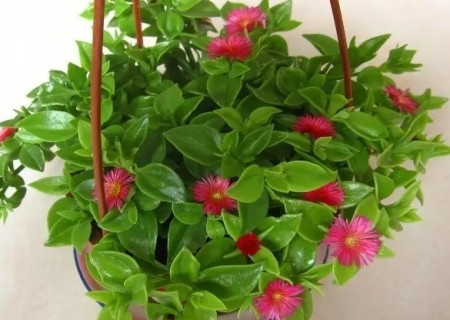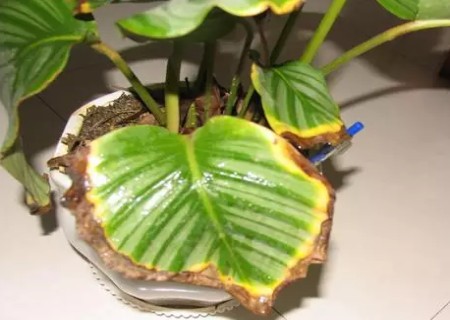What's wrong with the rotten roots of hanging orchids? What shall I do?
Due to uncontrolled watering, improper fertilization and poor management, potted flowers and trees are often easy to cause rotten roots, which destroys the flowers and trees carefully cultivated for years or even decades, which is really a pity. If we can make an accurate diagnosis in the early and middle stages of rotting roots, and take effective measures, it is expected to avoid the death of some flowers and trees. The following is to take the rotten roots of Cymbidium as an example to analyze the causes and treatment methods of rotten roots.
The rotting root of Cymbidium is mainly caused by root injury or waterlogging and excessive fertilization. Change, divide the basin must be as little as possible to hurt the root, and to dry after a day on the basin, and to control the amount of water, do not do not pour in order to avoid root rot. Long-term watering coupled with the impervious basin soil will also have this symptom.

It is advisable to apply thin fertilizer frequently, do not apply thick fertilizer or unripe raw fertilizer, otherwise it is very easy to burn roots. Now the plant can be poured out of the basin, the roots can be trimmed and placed in a cool place for 2-3 days, and then cultivated with new soil, as long as the new soil is loose, breathable, fertile and well drained.
How to deal with the rotten roots of hanging orchids:
First of all, it is necessary to dig up the orchid, cut off the rotten roots, and disinfect them with potassium permanganate solution. If there is no potassium permanganate, carbendazim is OK. If there is nothing on hand, clean up the rotten roots and put them in a ventilated place to dry. Do not bask in the sun, just dry in a cool place, and then replant it with new soil.
When it comes to replanting, because the orchid is a very easy plant to raise, if you have pure sand on hand, you can raise it with pure sand first. After my test, the pure sand can take root quickly!
Techniques for dealing with the following situations:
1. If the orchid is only slightly rotten, it is likely to be overwatered and the soil is too wet. At this time, you need to take good care of it so that it can recover slowly. The amount of water should be reduced every day, once in the morning and one night, and then slowly reduced to once a day or two days. In this way, the soil of the orchid will not be too wet, and the rotten root condition will slowly improve.
2, when the hanging orchid has signs of rotting roots, it should be moved out in time to bask in the sun, and be careful not to be exposed for a long time. See the sun has enough light on it, every day in the outdoor sun for about two hours, hanging orchid slightly rotting root symptoms will generally slowly improve.
3. After properly watering and basking in the sun, if the symptoms of rotting roots of Cymbidium are not alleviated, some plant nutrient solution can be used appropriately. It should be added strictly according to the instructions on the bottle, and don't use too much, so as not to be counterproductive. It is best to spray the leaves after being diluted with water in proportion, which is more conducive to the absorption of nutrients by plants than adding them to the soil.
4. under normal circumstances, there is not only one root of Cymbidium. If there are only a few rotten roots, the unrotten roots can be separated from the rotten roots and cultured in a new pot, which can ensure the continuous growth of Cymbidium, and the rotten roots can be thrown away.
5. If the rotten root of the orchid is very serious, the rotten root should be removed. Use a sterilized knife to cut off the rotten roots and throw them away, and the rest will be smeared with rooting agents and replaced with new soil, so that the orchids will slowly grow new flesh roots and thrive again.
6. If the roots of Cymbidium are completely rotten and there is little hope of regeneration, then transplant and cultivate them in time. The small plants on the stems of Cymbidium can be used for transplantation. in the growing season, the small plants on the stems are cut and planted in culture soil or water, and then transplanted to the basin after taking root. A new orchid can be successfully cultivated.
Personally, it is not as easy to raise orchids as green orchids indoors, and the most common problem is rotten roots. The rotting root of Cymbidium is mainly caused by root injury or waterlogging and excessive fertilization. So, how to avoid the rotten roots of the orchid?
Change the basin, split the basin must be as little as possible to hurt the root, and to dry for a day before the basin, and to control the amount of water, do not do not pour in order to avoid root rot. Long-term watering coupled with the impervious basin soil will also have this symptom. It is advisable to apply thin fertilizer frequently, do not apply thick fertilizer or unripe raw fertilizer, otherwise it is very easy to burn roots.
Time: 2019-05-31 Click:
- Prev

Why don't peony orchids blossom?-how do peony orchids blossom more?
Speaking of peony hanging orchid, I believe everyone will be no stranger, right? Peony Cymbidium is a kind of evergreen plant with small red flowers, which is of high ornamental value. It can also purify the air and absorb radiation, which is very good for human health. Peony orchid is a very popular indoor potted plant with lush green leaves.
- Next

What if the leaves of Guanyin turn yellow in potted plants?
Flower friends who have raised dripping Guanyin know that dripping Guanyin is easy to raise, but what if the leaves turn yellow when I encounter dripping Guanyin? First of all, flower friends should find out the cause of the yellowing of Dishui Guanyin leaves, and then solve the problem. According to the reflection of flower friends in the past and the characteristics of Dishui Guanyin
Related
- Fuxing push coffee new agricultural production and marketing class: lack of small-scale processing plants
- Jujube rice field leisure farm deep ploughing Yilan for five years to create a space for organic food and play
- Nongyu Farm-A trial of organic papaya for brave women with advanced technology
- Four points for attention in the prevention and control of diseases and insect pests of edible fungi
- How to add nutrient solution to Edible Fungi
- Is there any good way to control edible fungus mites?
- Open Inoculation Technology of Edible Fungi
- Is there any clever way to use fertilizer for edible fungus in winter?
- What agents are used to kill the pathogens of edible fungi in the mushroom shed?
- Rapid drying of Edible Fungi

